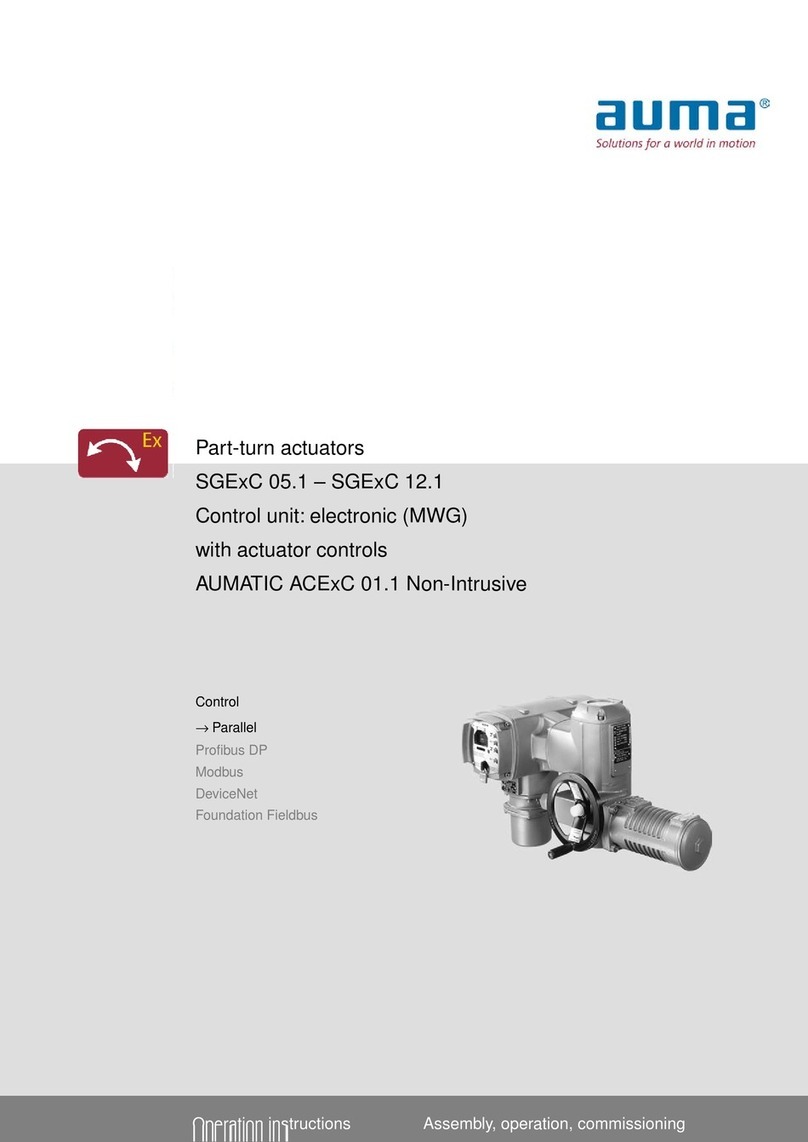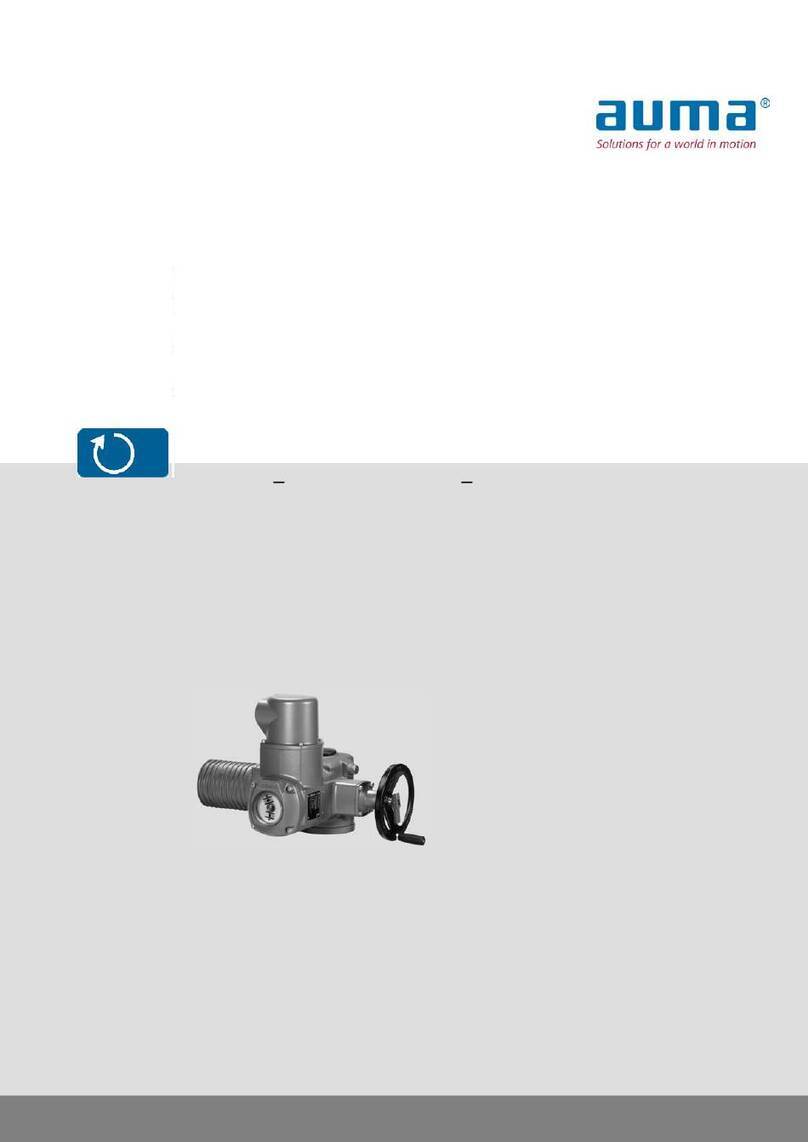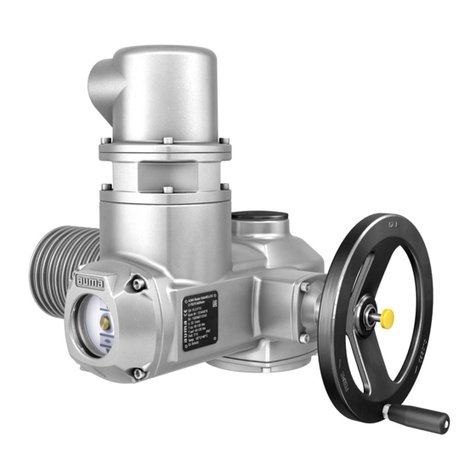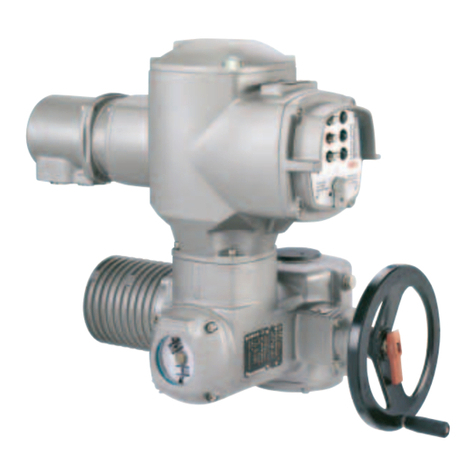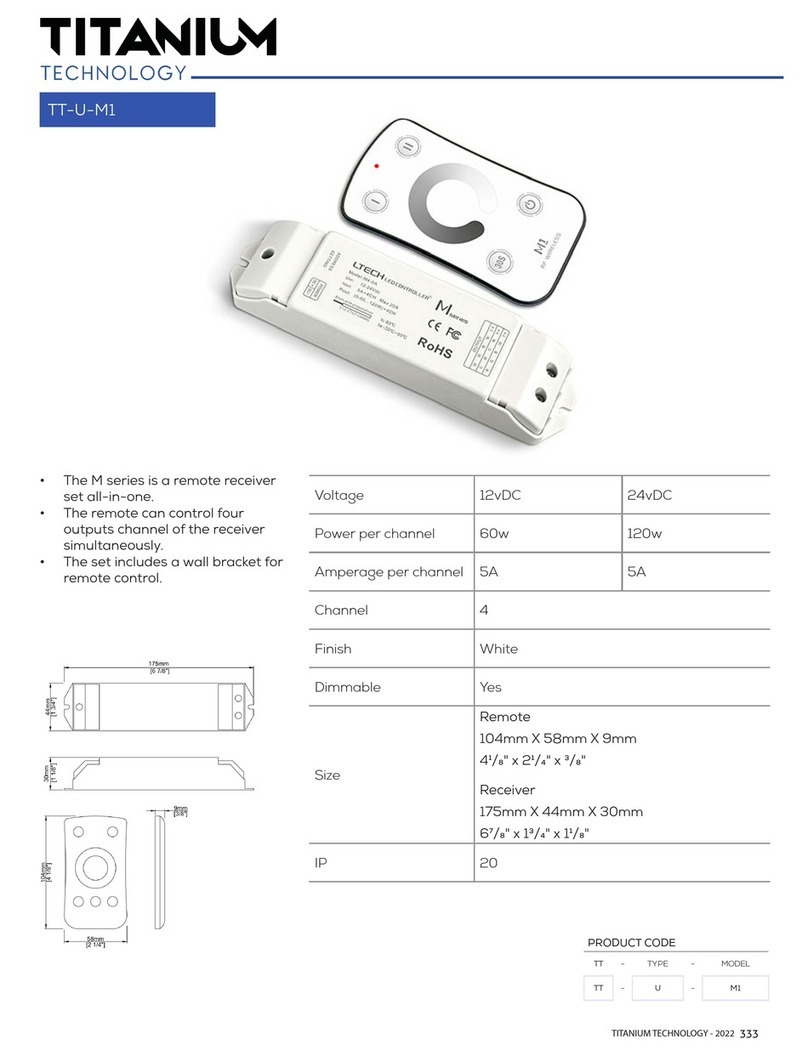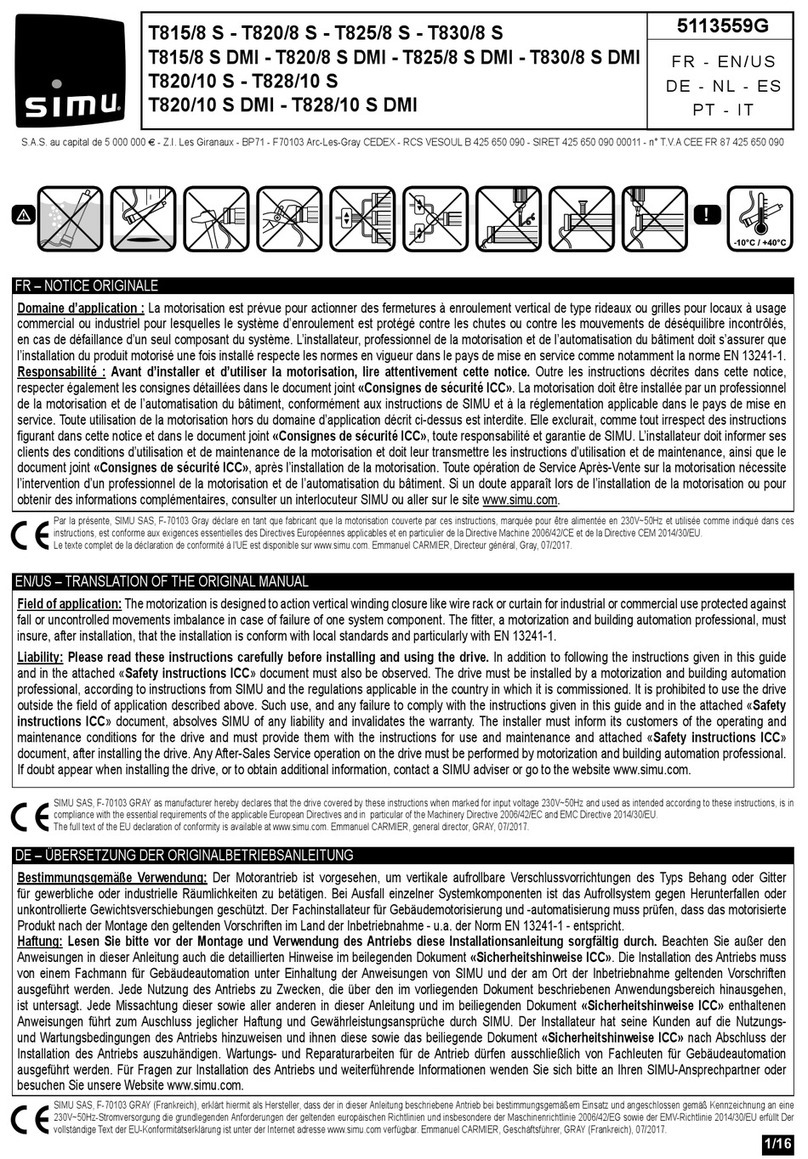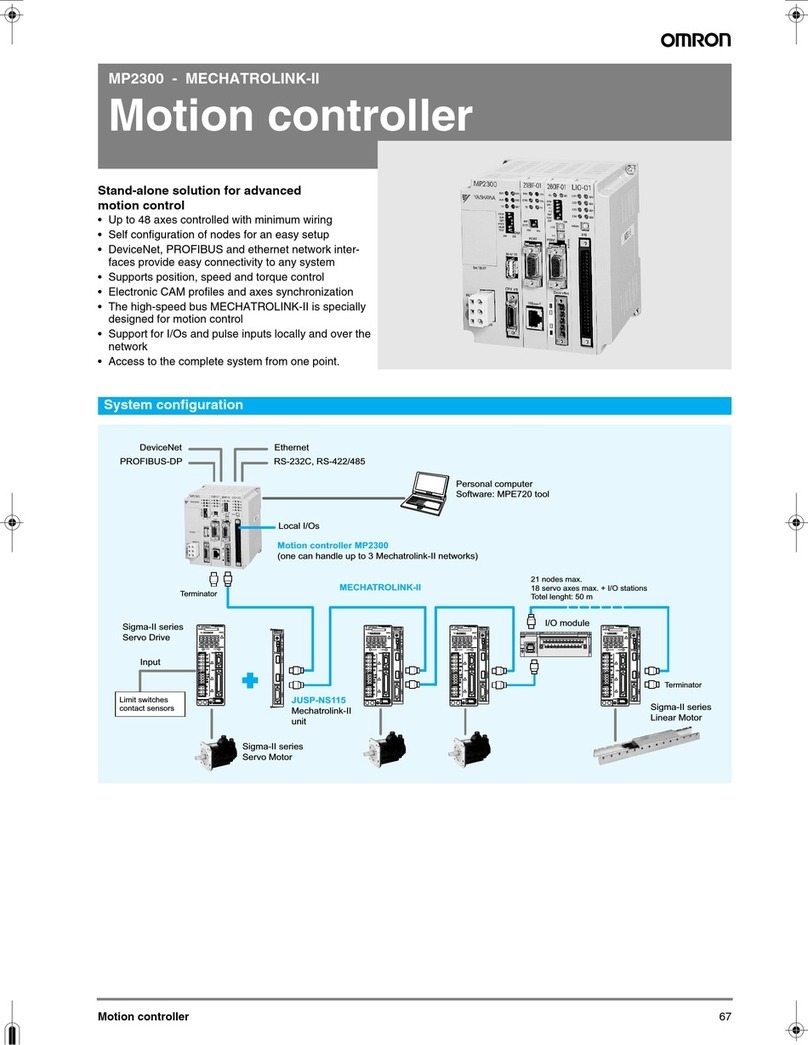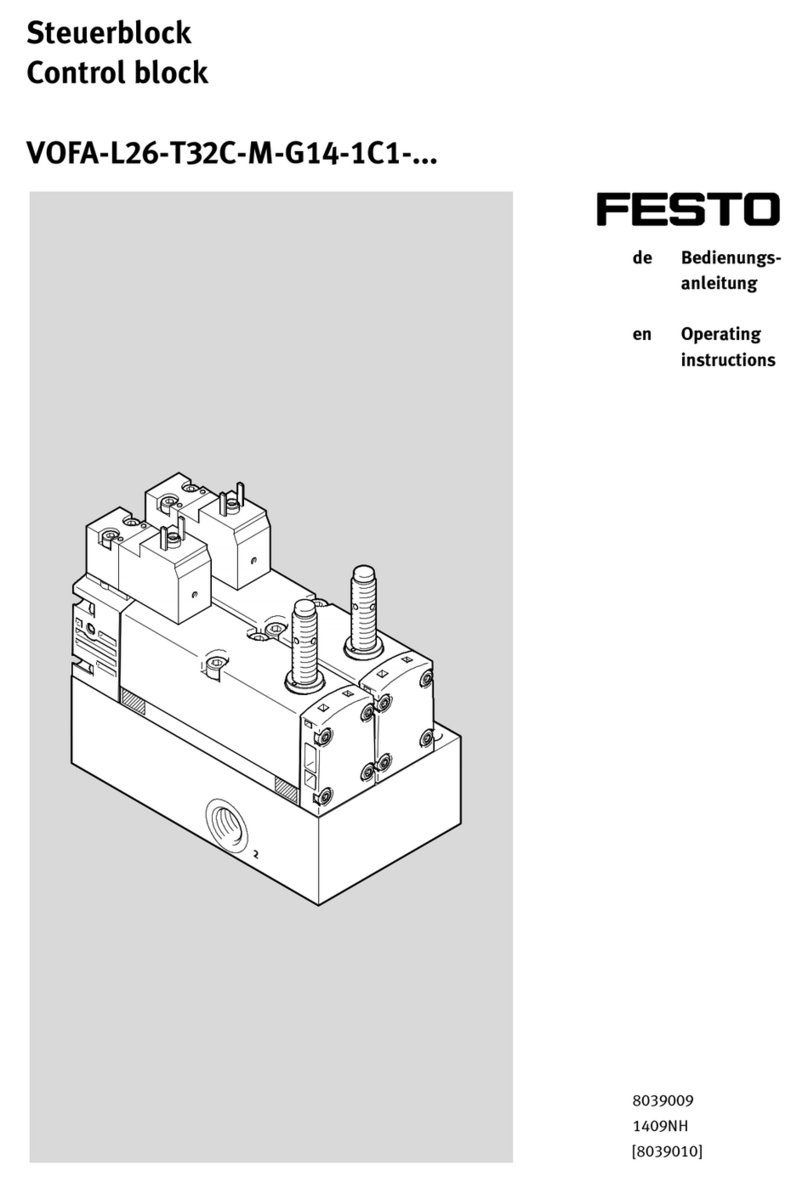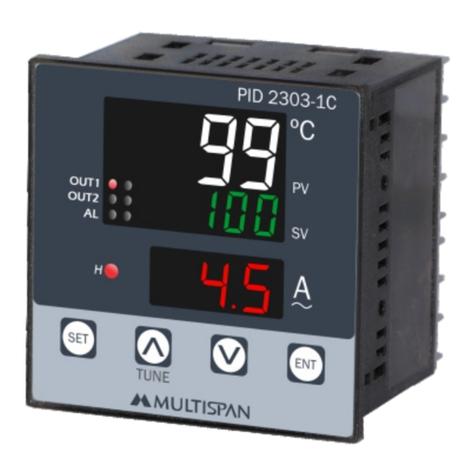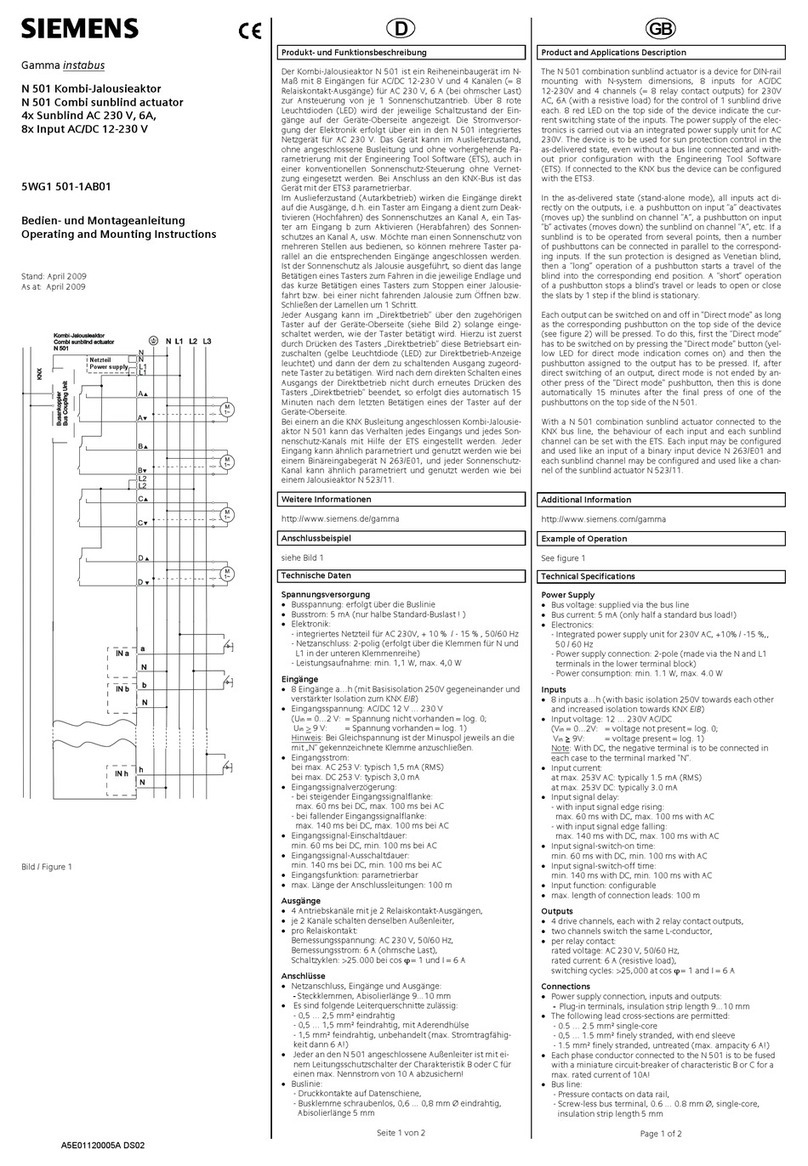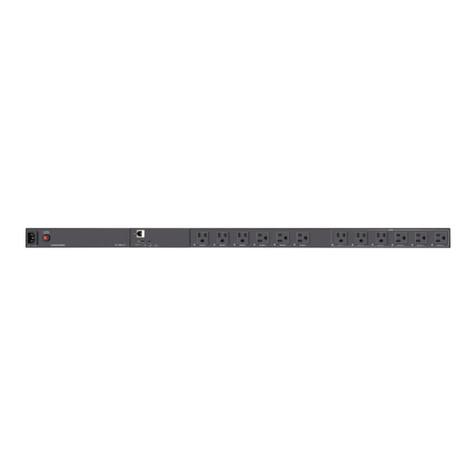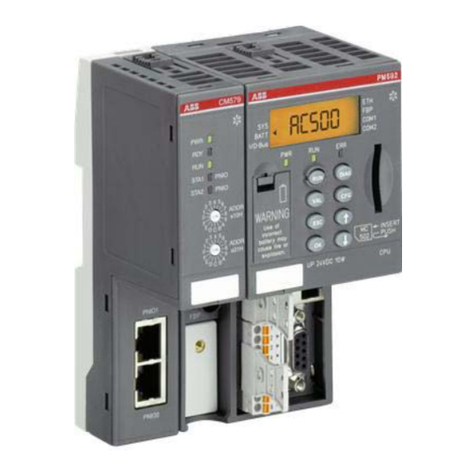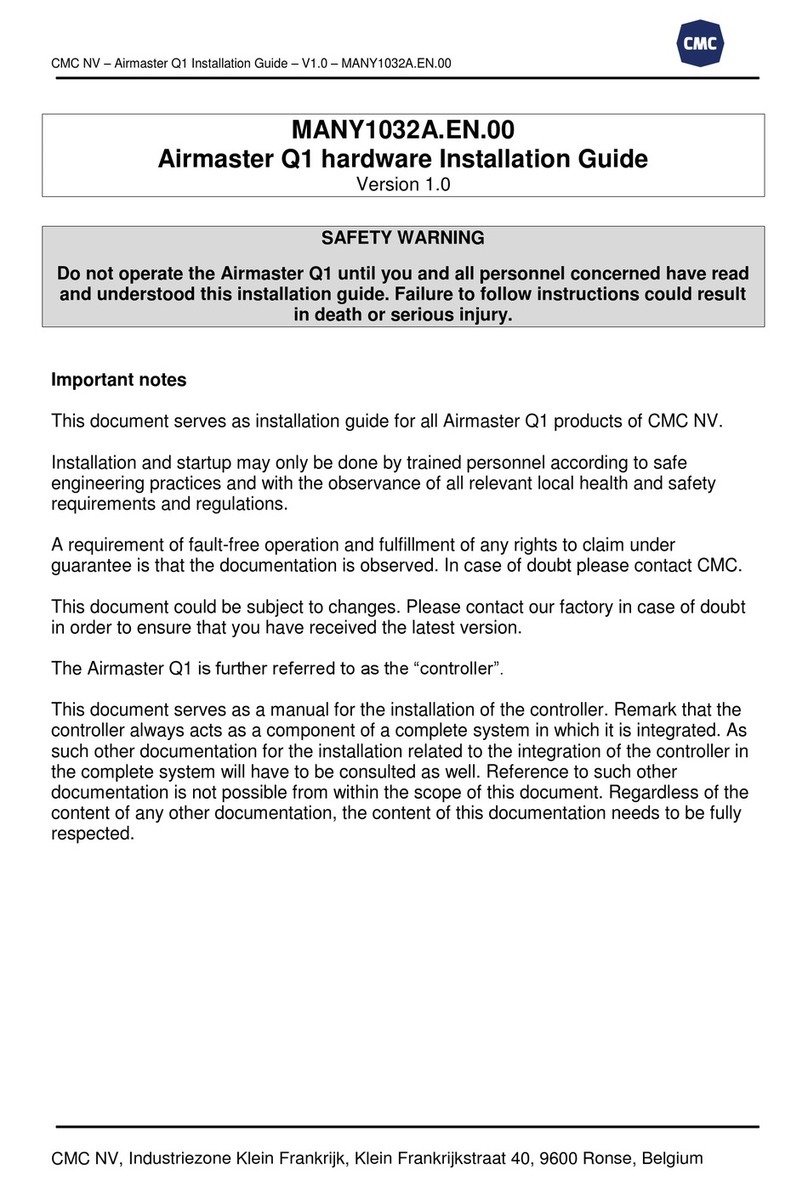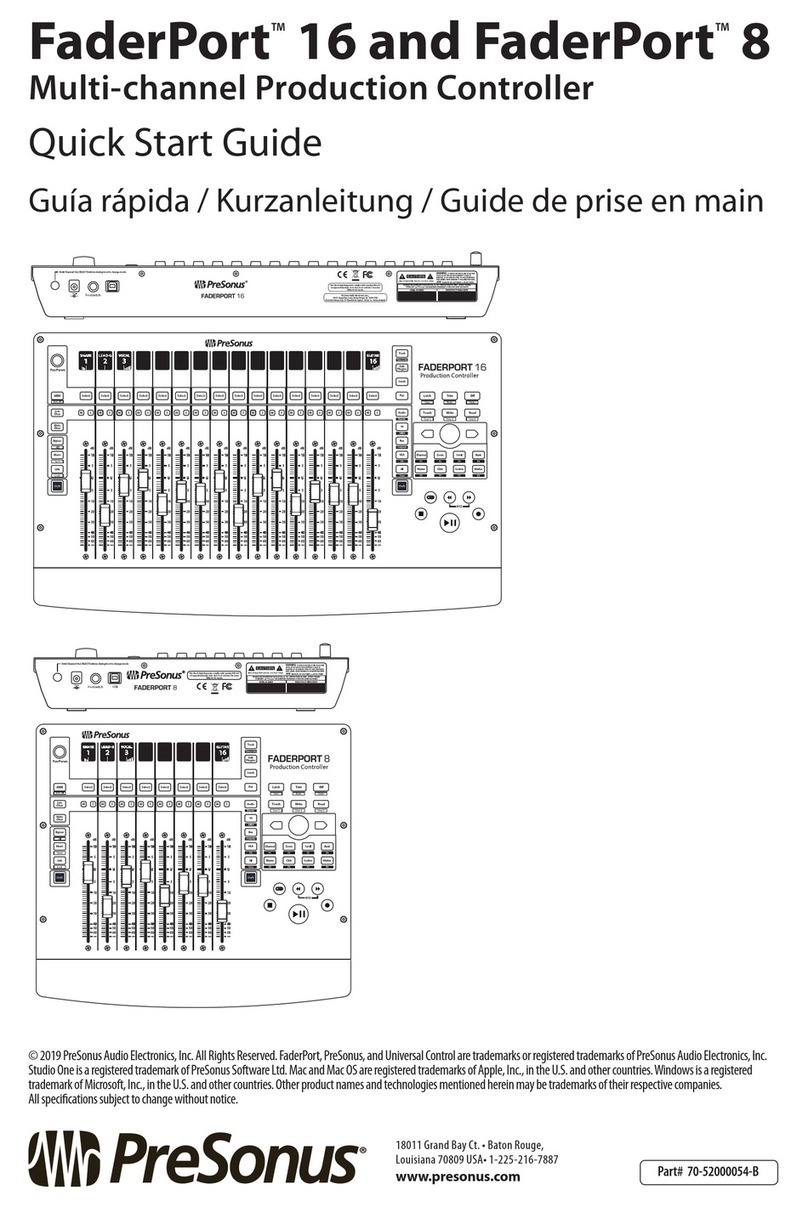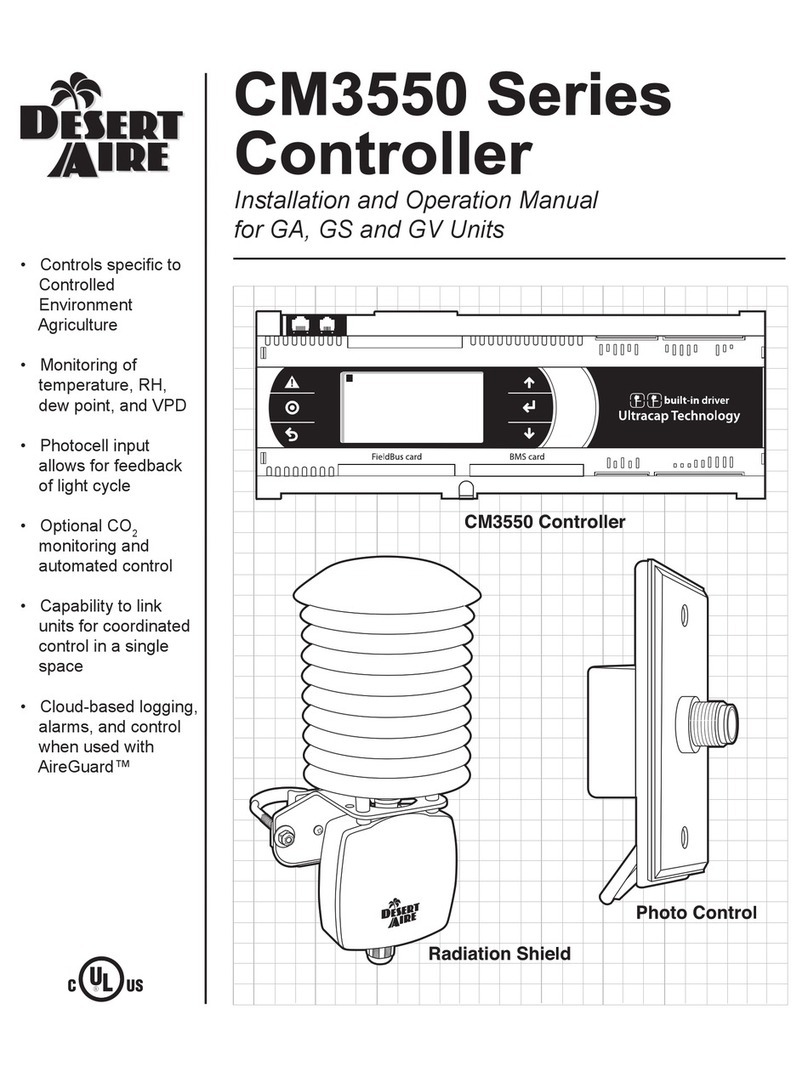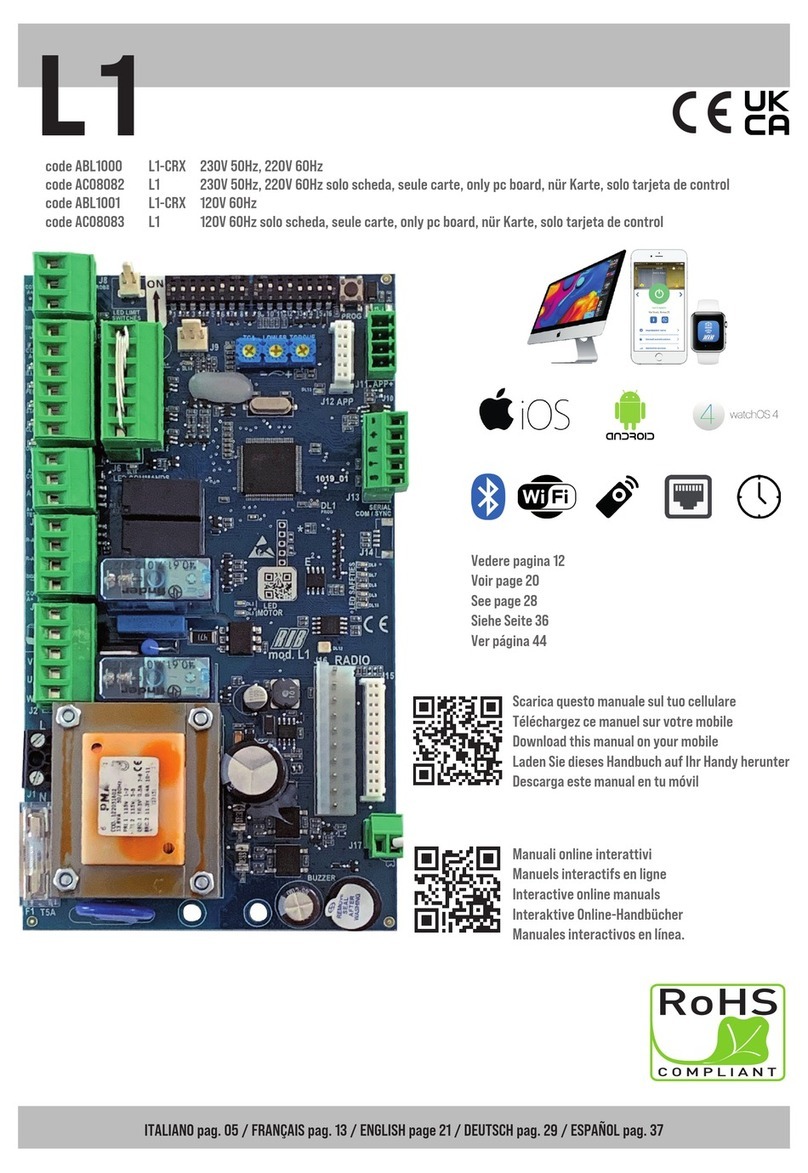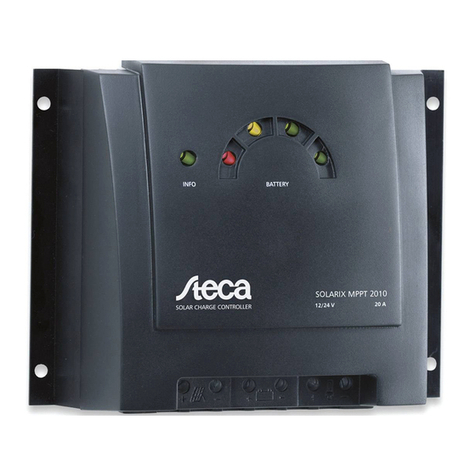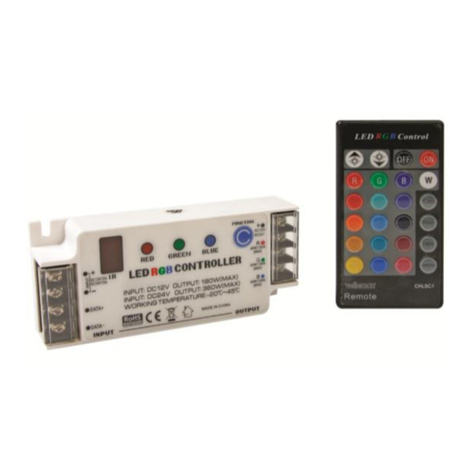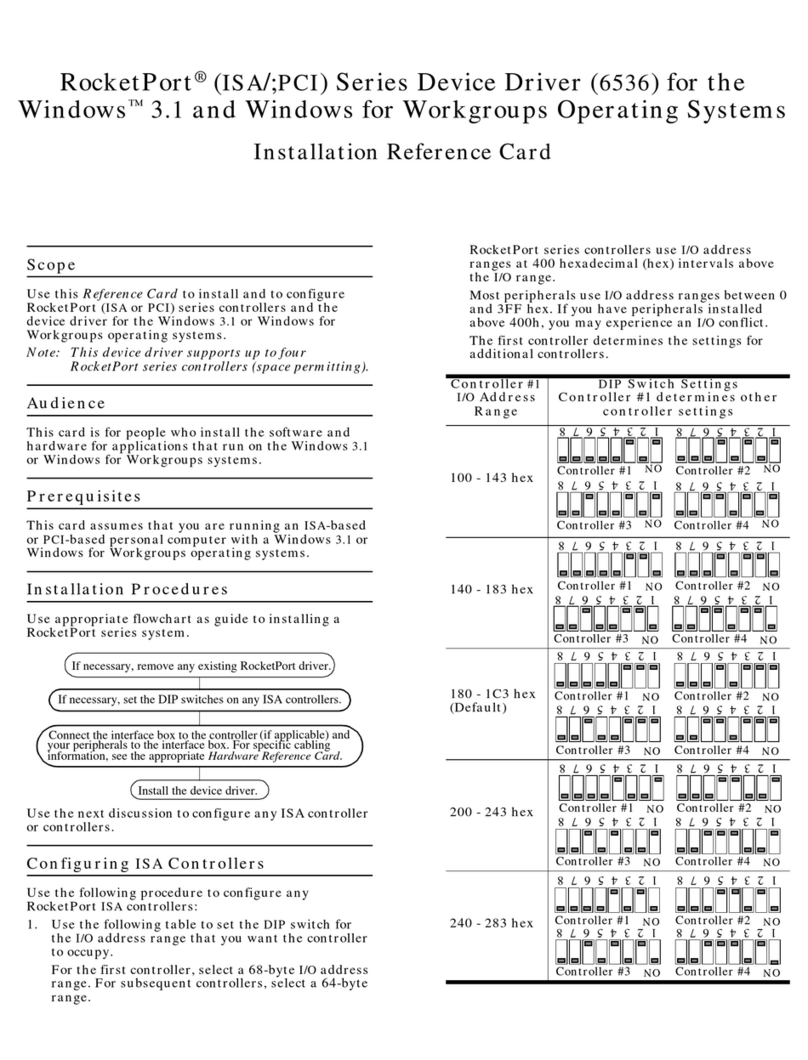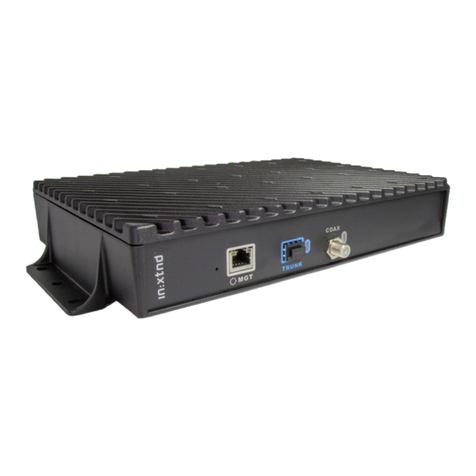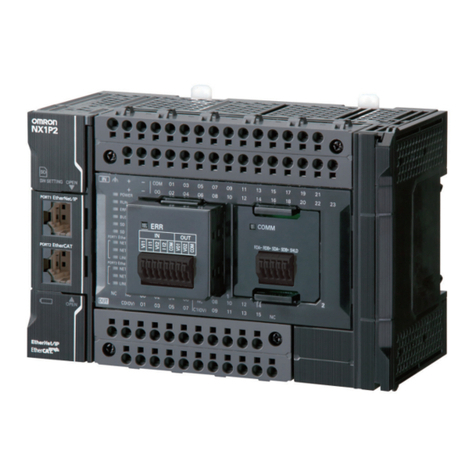AUMA SQEx 05.2 User manual

Operation instructions
Assembly and commissioning
Part-turn actuators
SQEx 05.2 – SQEx 14.2
SQREx 07.2 – SQREx 14.2
AUMA NORM actuator (without controls)

Table of contents
2
Target group:
This document contains information for assembly, commissioning and maintenance staff.
Read operation instructions first.
• Heed safety instructions.
• These operation instructions are part of the product.
• Store operation instructions during product life.
• Pass on instructions to any subsequent user or owner of the product.
Table of contents
1 Safety instructions ........................................................................................................................................... 4
1.1 Prerequisites for the safe handling of the product...................................................................................... 4
1.2 Range of application .................................................................................................................................. 5
1.3 Warnings and notes ................................................................................................................................... 6
1.4 References and symbols............................................................................................................................ 6
2 Short description.............................................................................................................................................. 7
3 Name plate ........................................................................................................................................................ 8
4 Transport and storage ..................................................................................................................................... 11
4.1 Transport.................................................................................................................................................... 11
4.2 Storage....................................................................................................................................................... 12
5 Assembly .......................................................................................................................................................... 13
5.1 Mounting position ....................................................................................................................................... 13
5.2 Fit handwheel............................................................................................................................................. 13
5.3 Mount actuator to valve.............................................................................................................................. 13
5.3.1 Overview on coupling variants ........................................................................................................ 14
6 Electrical connection ....................................................................................................................................... 17
6.1 Basic information........................................................................................................................................ 17
6.2 Overview of AUMA electrical connections ................................................................................................. 18
6.3 KT/KM electrical connection....................................................................................................................... 19
6.3.1 Open terminal compartment ........................................................................................................... 20
6.3.2 Cable connection ............................................................................................................................ 21
6.3.3 Close terminal compartment ........................................................................................................... 23
6.4 KES electrical connection .......................................................................................................................... 24
6.4.1 Open terminal compartment ........................................................................................................... 25
6.4.2 Cable connection ............................................................................................................................ 26
6.4.3 Close terminal compartment ........................................................................................................... 27
6.5 External earth connection .......................................................................................................................... 28
6.6 Accessories for electrical connection (option)............................................................................................ 28
6.6.1 Parking frame.................................................................................................................................. 28
7 Operation .......................................................................................................................................................... 29
7.1 Manual operation ....................................................................................................................................... 29
7.1.1 Manual valve operation................................................................................................................... 29
7.2 Motor operation .......................................................................................................................................... 29
8 Indications (option) .......................................................................................................................................... 30
8.1 Mechanical position indication via indicator mark ...................................................................................... 30
9 Signals (output signals)................................................................................................................................... 31

Table of contents
3
9.1 Feedback signals from actuator ................................................................................................................. 31
10 Commissioning (basic settings) ..................................................................................................................... 32
10.1 End stops in part-turn actuator................................................................................................................... 32
10.1.1 Set end stop CLOSED .................................................................................................................... 33
10.1.2 Set end stop OPEN......................................................................................................................... 33
10.2 Open switch compartment ......................................................................................................................... 33
10.3 Set torque switching................................................................................................................................... 34
10.4 Set limit switching....................................................................................................................................... 35
10.4.1 Set end position CLOSED (black section) ...................................................................................... 35
10.4.2 Set end position OPEN (white section)........................................................................................... 36
10.5 Test run ...................................................................................................................................................... 36
10.5.1 Check direction of rotation at mechanical position indicator ........................................................... 36
10.5.2 Check limit switching....................................................................................................................... 37
10.6 Set mechanical position indicator............................................................................................................... 37
10.7 Close switch compartment ......................................................................................................................... 38
11 Commissioning (optional equipment settings) ............................................................................................. 39
11.1 Potentiometer............................................................................................................................................. 39
11.1.1 Potentiometer setting ...................................................................................................................... 39
11.2 RWG electronic position transmitter........................................................................................................... 39
11.2.1 Set measuring range....................................................................................................................... 40
11.3 EWG 01.1 electronic position transmitter................................................................................................... 40
11.3.1 Set measuring range....................................................................................................................... 41
11.3.2 Adjust current values ...................................................................................................................... 42
11.3.3 Switch on/off LED end position signalling ....................................................................................... 43
11.4 Set intermediate positions.......................................................................................................................... 43
11.4.1 Set running direction CLOSE (black section).................................................................................. 43
11.4.2 Set running direction OPEN (white section).................................................................................... 44
12 Corrective actions ............................................................................................................................................ 45
12.1 Faults during operation/commissioning...................................................................................................... 45
12.2 Motor protection (thermal monitoring) ........................................................................................................ 46
13 Servicing and maintenance............................................................................................................................. 47
13.1 Preventive measures for servicing and safe operation .............................................................................. 47
13.2 Disconnection from the mains.................................................................................................................... 47
13.2.1 Disconnection from the mains with KT/KM electrical connection.................................................... 48
13.2.2 Mains disconnection with KES electrical connection ...................................................................... 49
13.3 Maintenance............................................................................................................................................... 49
13.4 Disposal and recycling ............................................................................................................................... 50
14 Technical data .................................................................................................................................................. 52
14.1 Technical data Part-turn actuator............................................................................................................... 52
14.2 Tightening torques for screws .................................................................................................................... 54
15 Spare parts list ................................................................................................................................................. 55
15.1 Part-turn actuators SQEx 05.2 – SQEx 14.2 KT/KM / SQREx 05.2 – SQREx 14.2 KT/KM....................... 55
Index .................................................................................................................................................................. 57

Safety instructions
4
1Safety instructions
1.1 Prerequisites for the safe handling of the product
Standards/directives The end user or the contractor must ensure that all legal requirements, directives,
guidelines, national regulations and recommendations with respect to assembly, elec-
trical connection, commissioning and operation are met at the place of installation.
Depending on the device version, this includes:
• Standards and directives such as IEC60079:
Part 14: Electrical installations design, selection and erection.
Part 17: Electrical installations inspection and maintenance.
• Configuration guidelines for the respective fieldbus or network applications.
Safety instructions/warn-
ings
All personnel working with this device must be familiar with the safety and warning in-
structions in this manual and heed the instructions given. Safety instructions and
warning signs on the device must be observed to avoid personal injury or property
damage.
Qualification of staff Assembly, electrical connection, commissioning, operation, and maintenance must be
carried out by suitably qualified personnel authorised by the end user or contractor of
the plant only.
Prior to working on this product, the staff must have thoroughly read and understood
these instructions and, furthermore, know and observe officially recognised rules re-
garding occupational health and safety.
Work performed in potentially explosive atmospheres is subject to special regulations
which have to be observed. The end user or contractor of the plant is responsible for
respect and control of these regulations, standards, and laws.
Electrostatic charging Highly efficient charge generating processes (processes more efficient than manual
friction) on the device surface must be excluded at any time. Highly efficient charge
generating processes will lead to propagating brush discharges and therefore to igni-
tion of a potentially explosive atmosphere. This safety instruction also applies to fire-
proof coatings or covers available as an option.
When using a stem protection tube, any type of charge generating processes must be
excluded at its protective cap as well as the V-seal (e.g. only wipe with a damp cloth).
Otherwise, ignitable electrostatic discharges might occur.
Ignition hazards Gearings were subjected to an ignition hazard assessment in compliance with the cur-
rently applicable standard according to ISO 80079-36/ -37. Hot surfaces, mechanically
generated sparks as well as static electricity and stray electric currents were identified
and assessed as major potential ignition sources. Protective measures to prevent the
likelihood that ignition sources arise were applied to the gearboxes. This includes in
particular lubrication of the gearbox, the protection level of enclosure protection and
the warnings and notes contained in these operation instructions.
Commissioning Prior to commissioning, imperatively check that all settings meet the requirements of
the application. Incorrect settings might present a danger to the application, e.g. cause
damage to the valve or the installation. The manufacturer will not be held liable for any
consequential damage. Such risk lies entirely with the user.
Operation Prerequisites for safe and smooth operation:
• Correct transport, proper storage, mounting and installation, as well as careful
commissioning.
• Only operate the device if it is in perfect condition while observing these instruc-
tions.
• Immediately report any faults and damage and allow for corrective measures.
• Heed recognised rules for occupational health and safety.
• Heed national regulations.

Safety instructions
5
• During operation, the housing warms up and surface temperatures > 60°C may
occur. To prevent possible burns, we recommend checking the surface temperat-
ure using an appropriate thermometer and wearing protective gloves, prior to
working on the device.
Protective measures The end user or the contractor are responsible for implementing required protective
measures on site, such as enclosures, barriers, or personal protective equipment for
the staff.
Maintenance To ensure safe device operation, the maintenance instructions included in this manual
must be observed.
Any device modification requires prior written consent of the manufacturer.
1.2 Range of application
AUMA part-turn actuators SQEx/SQREx are designed for the operation of industrial
valves, e.g. butterfly valves and ball valves.
The devices described below are approved for use in the potentially explosive atmo-
spheres of zones 1, 2, 21, and 22.
If temperatures > 40°C are to be expected at the valve flange or the valve stem (e.g.
due to hot media), please consult AUMA.
Temperatures > 40 °C are not considered with regards to the non-electrical explosion
protection.
Other applications require explicit (written) confirmation by the manufacturer.
The following applications are not permitted, e.g.:
• Industrial trucks according to EN ISO 3691
• Lifting appliances according to EN 14502
• Passenger lifts according to DIN 15306 and 15309
• Service lifts according to EN 81-1/A1
• Escalators
• Continuous duty
• Buried service
• Continuous underwater use (observe enclosure protection)
• Potentially explosive areas of zones 0 and 20
• Potentially explosive areas of group I (mining)
• Radiation exposed areas in nuclear power plants
No liability can be assumed for inappropriate or unintended use.
Observance of these operation instructions is considered as part of the device's desig-
nated use.
These operation instructions are only valid for the “clockwise closing” standard ver-
sion, i.e. driven shaft turns clockwise to close the valve. For “counterclockwise closing”
version, a supplement must be observed in addition to these operation instructions.
Particular conditions of use
The particular conditions of use are listed on the certificates supplied. Among others,
this includes the following conditions:
• For further references to minimise the risk of electrostatic charging within a poten-
tially explosive atmosphere, refer to Prerequisites for the safe handling of the
product [}4].
• For information regarding the dimensions of the flameproof joints, contact the
manufacturer.
• Special fasteners according to IEC 60079-0 to seal flameproof enclosures must
have the following strength classes:

Safety instructions
6
– Minimum A*-70 for all special fasteners, excluding screws for fixing motors of
VKX type
– Minimum A*-80 for screws for fixing motors of VKX type
• For tightening the screws, refer to Tightening torques for screws [}54].
1.3 Warnings and notes
The following warnings draw special attention to safety-relevant procedures in these
operation instructions, each marked by the appropriate signal word (DANGER,
WARNING, CAUTION, NOTICE).
DANGER Indicates an imminently hazardous situation with a high level of risk.
Failure to observe this warning results in death or serious injury.
WARNING Indicates a potentially hazardous situation with a medium level of risk.
Failure to observe this warning could result in death or serious injury.
CAUTION Indicates a potentially hazardous situation with a low level of risk. Fail-
ure to observe this warning could result in minor or moderate injury. May
also be used with property damage.
NOTICE Potentially hazardous situation. Failure to observe this warning could
result in property damage. Is not used for personal injury.
The safety symbol warns of a potential personal injury hazard.
The signal word (here: DANGER) indicates the level of hazard.
1.4 References and symbols
The following references and symbols are used in these instructions:
The term Information preceding the text indicates important notes and inform-
ation.
Information The term Information is part of an instruction and gives important notes and informa-
tion with regard to an action step.
Symbol for CLOSED (valve closed)
Symbol for OPEN (valve open)
Result of a process step
Describes the result of a preceding process step.
Action step
Describes one single action step.
Reference to the page number
Refers to the page number for further information. To return from the target to the pre-
vious view, it is possible to jump back to the previous view within PDF documents:
When using Adobe Acrobat via Menu > Previous view, or using the key combination
Alt + left.

Short description
7
2Short description
Part-turn actuator Definition according to ISO 22153:
A part-turn actuators is an actuator which transmits torque to the valve for less than
one revolution, and does not need to be capable of withstanding operational thrust.
AUMA part-turn actuator Figure1: AUMA SQEx 10.2 part-turn actuator
[1]
[2]
[3]
[4]
[5]
[1] Motor [2] Electrical connection
[3] Handwheel [4] Valve attachment
[5] Mechanical position indicator
AUMA part-turn actuators SQEx/SQREx are driven by an electric motor. A handwheel
is available for setting and emergency operation.
Actuator controls are required to operate or process the actuator signals.
Actuators without controls can be equipped with AUMA actuator controls at a later
date. For any queries, please state our order number. The order number is available
on the name plate. (Refer to Actuator name plate [}8].)
Switching off in end positions may be either by limit or torque seating.

Name plate
8
3Name plate
Figure2: Arrangement of name plates
[1]
[2] [3][4]
[1] Motor name plate [2] Actuator name plate
[3] Additional plate, e.g. KKS plate (Power
Plant Classification System)
[4] Explosion protection approval plate
Actuator name plate
Figure3: Actuator name plate (example)
[1]
[2]
[3]
[4]
[5]
[6]
[7]
[8]
[9]
[10]
[11]
[12]
[13]
[1] Name of manufacturer [2] Address of manufacturer
[3] Type designation [4] Order number
[5] Serial number [6] Operating time
[7] Torque range in direction CLOSE [8] Torque range in direction OPEN
[9] Type of lubricant [10] Permissible ambient temperature
[11] Can be assigned as an option upon
customer request
[12] Enclosure protection
[13] Data Matrix code

Name plate
9
Motor name plate
Figure4: Motor name plate (example)
[1]
[2]
[3]
[4]
[5]
[6]
[7]
[8]
[9]
[10]
[11]
[12]
[13]
[14]
[1] Motor type [2] Motor article number
[3] Serial number [4] Current type, mains voltage
[5] Nominal power [6] Nominal current
[7] Type of duty [8] Enclosure protection
[9] Motor protection (temperature protec-
tion)
[10] Insulation class
[11] Speed [12] Power factor cos phi
[13] Mains frequency [14] Data Matrix code
Approval plate in explosion-proof version
Figure5: Approval plates in explosion-proof version (examples)
IECEx DEK 12.0080X
Ex db eb IIC T4 Gb
Ex tb IIIC T130°C Db
M20 + M25 + M32
[1]
[2]
[3]
[4]
[5]
[6]
[7]
[1]
[2]
[3]
[4]
[6]
[7]
ATEX IECEx
[1] Ex symbol, CE mark, number of test
authority
[2] Ex certificate (number)
[3] Classification for electrical gas explo-
sion protection
[4] Classification for electrical dust explo-
sion protection
[5] Classification for non-electrical explo-
sion protection
[6] Threads for cable entries at electrical
connection
[7] Not used
Descriptions referring to name plate indications
Type designation Table1: Description of type designation with the example of SQEx 07.2-F10
SQEx 07.2 -F10
SQEx Type SQEx = Part-turn actuators for open-close duty
Type SQREx = Part-turn actuators for modulating duty
07.2 Size
These instructions apply to sizes 05.2, 07.2, 10.2, 12.2, 14.2
F10 Flange size
Ex marking Table2: Description of the Ex marking with the example of /-a3b1
– a 3 b 1
– Not used

Name plate
10
– a 3 b 1
a
Motor type
a = ADX or VDX: 3-phase AC motor
b = AEX, ACX, VEX, VCX: 1-phase AC motor
3
Protection type of electrical connection
3 = Terminal compartment Ex e increased safety
4 = Terminal compartment Ex d flameproof enclosure
b
Protection type of position transmitter
a = Without intrinsically safe electric circuit
b = Electric circuit Ex i Intrinsic safety (RWG 5020.2Ex)
1
Protection type of fieldbus
1 = without intrinsically safe Ex ic fieldbus connection
3 = Ex ic intrinsically safe fieldbus connection
Order number The product can be identified using this number and the technical data as well as or-
der-related data pertaining to the device can be requested.
Please always state this number for any product inquiries.
On our website at http://www.auma.com, via Service & Support| myAUMA, we of-
fer a service allowing authorised users to download order-related documents such as
wiring diagrams and technical data (both in German and English), inspection certific-
ate and the operation instructions when entering the order number.
Actuator serial number Table3: Serial number until 2023, description with the example of 0523NS12345
05 23 NS12345
05 Positions 1+2: Assembly in week = week 05
23 Positions 3+4: Year of manufacture = 2023
NS12345 Internal number for unambiguous product identification
Table4: Serial number as from 2024, description with the example 0000-00101-2024
00000-00101 – 2024
00000-00101 Serial number of sales article
11-digit, internal number for unambiguous product identification
2024 Year of manufacture = 2024
Data Matrix code When registered as authorised user, you may use our AUMA Assistant App to scan
the Data Matrix code and directly access the order-related product documents without
having to enter order number or serial number.
Figure6: Link to AUMA Assistant App
For further Service & Support, Software/Apps/..., refer to www.auma.com.

Transport and storage
11
4Transport and storage
4.1 Transport
Actuator For transport to place of installation, use sturdy packaging.
DANGER Suspended load!
Death or serious injury.
àDo NOT stand below suspended load.
àAttach ropes or hooks for the purpose of lifting by hoist only to housing and NOT
to handwheel.
àActuators mounted on valves: Attach ropes or hooks for the purpose of lifting by
hoist to valve and NOT to actuator.
àActuators mounted to gearboxes: Attach ropes or hooks for the purpose of lifting
by hoist only to the gearbox using eyebolts and NOT to the actuator.
àRespect total weight of combination (actuator, gearbox, valve)
àSecure load against falling down, sliding or tilting.
àPerform lift trial at low height to eliminate any potential danger e.g. by tilting.
Figure7: Example: Lifting the actuator
Weights Table5: Weights for SQEx/SQREx part-turn actuators with 3-phase AC motors
Type designation
Actuator
Weight
1) Weight with base and lever
2)
approx. [kg] approx. [kg]
SQEx 05.2/
SQREx 05.2 29 34
SQEx 07.2/
SQREx 07.2 29 34
SQEx 10.2/
SQREx 10.2 34 38
SQEx 12.2/
SQREx 12.2 42 50
SQEx 14.2/
SQREx 14.2 51 62
1) Indicated weight includes AUMA NORM part-turn actuator with 3-phase AC motor, electrical connec-
tion in standard version, unbored coupling and handwheel For other output drive types, consider ad-
ditional weights.
2) Indicated weight includes AUMA NORM part-turn actuator with 3-phase AC motor, electrical connec-
tion in standard version, and handwheel, including base and lever For other output drive types, con-
sider additional weights.

Transport and storage
12
Table6: Weights for SQEx/SQREx part-turn actuators with 1-phase AC motors
Type designation
Actuator
Weight
1) Weight with base and lever
2)
approx. [kg] approx. [kg]
SQEx 05.2/
SQREx 05.2 33 39
SQEx 07.2/
SQREx 07.2 33 39
SQEx 10.2/
SQREx 10.2 39 43
SQEx 12.2/
SQREx 12.2 47 55
SQEx 14.2/
SQREx 14.2 56 67
1) Indicated weight includes part-turn actuator AUMA NORM with 1-phase AC motor, electrical connec-
tion in standard version, unbored coupling and handwheel For other output drive types, consider ad-
ditional weights.
2) Indicated weight includes AUMA NORM part-turn actuator with 1-phase AC motor, electrical connec-
tion in standard version, and handwheel, including base and lever For other output drive types, con-
sider additional weights.
4.2 Storage
NOTICE Danger of corrosion due to inappropriate storage!
àStore in a well-ventilated, dry room.
àProtect against floor dampness by storage on a shelf or on a wooden pallet.
àCover to protect against dust and dirt.
àApply suitable corrosion protection agent to uncoated surfaces.
Long-term storage For long-term storage (more than 6 months), observe the following points:
1. Prior to storage: Protect uncoated surfaces, in particular the output drive parts and
mounting surface, with long-term corrosion protection agent.
2. At an interval of approx. 6 months: Check for corrosion. If first signs of corrosion
show, apply new corrosion protection.

Assembly
13
5Assembly
5.1 Mounting position
When using grease as lubricant, the product described herein can be operated in any
mounting position.
When using oil instead of grease within the actuator gear housing, perpendicular
mounting position is specified whereby the flange is pointing downward. The type of
lubricant used is indicated on the actuator name plate (short designation F...= grease;
O...= oil).
5.2 Fit handwheel
Figure8: Handwheel
[1]
[2] [3]
[4]
[1] Spacer [2] Input shaft
[3] Handwheel [4] Retaining ring
How to proceed 1. If required, fit spacer [1] on input shaft [2].
2. Slip handwheel [3] onto input shaft.
3. Secure handwheel [3] with retaining ring [4].
Information:The retaining ring [4] (together with these operation instructions) is
stored in a weatherproof bag, which is attached to the device prior to delivery.
5.3 Mount actuator to valve
NOTICE Corrosion due to damage to paint finish and condensation!
àTouch up damage to paint finish after work on the device.
àAfter mounting, connect the device immediately to electrical mains to ensure that
heater minimises condensation.
The actuator is mounted to the valve using a coupling (standard) or via lever. Separ-
ate instructions are available for actuator mounting to the valve when equipped with
base and lever.

Assembly
14
5.3.1 Overview on coupling variants
Set-up Figure9: Valve attachment via coupling
[1] [2] [3]
[1] Bore with keyway [2] Square bore
[3] Bore with two-flats
Application • For valve attachments according to EN ISO 5211
• For rotating, non-rising valve stem
5.3.1.1 Actuator (with coupling): mount
Unbored couplings or couplings with pilot bore must be machined to match the valve
shaft prior to mounting the actuator to the valve (e.g. with bore and keyway, two-flat or
square bore).
Assemble valve and actuator in the same end position. As standard, the actu-
ator is supplied in end position CLOSED.
a) Recommended mounting position for butterfly valves: End position CLOSED.
b) Recommended mounting position for ball valves: End position OPEN.
We recommend applying liquid thread sealing material to the screws to avoid
contact corrosion.
Assembly steps 1. If required, move actuator in same end position as valve using the handwheel.
2. Clean mounting faces, thoroughly degrease uncoated mounting surfaces.
3. Apply a small quantity of grease to the valve shaft [2].
4. Place coupling [1] onto valve shaft [2] and secure against axial slipping by using a
grub screw [3] or a clamping washer and a screw with curved spring lock washer
[4]. Observe dimensions X, Y or L. Refer to following picture and table Mounting
positions for coupling.

Assembly
15
Figure10: Examples: Fit coupling
[1]
[2]
[3]
[4]
[1]
[2]
[1] Coupling [2] Valve shaft
[3] Grub screw [4] Clamping washer and screw with
curved spring lock washer
Figure11: Mounting positions for coupling
XY
L
Table7: Mounting position of the coupling within fitting dimensions according to AUMA defini-
tion
Dimensions [mm] SQEx 05.2 SQEx 07.2 SQEx 10.2 SQEx 12.2 SQEx 14.2
EN ISO 5211 F05 F07 F05 F07 F10 F10 F12 F12 F14 F14 F16
X max. 3 3 3 3 3 4 4 5 5 8 8
Y max. 2 2 2 2 2 5 5 10 10 10 10
L max. 40 40 40 40 66 50 82 61 101 75 125
5. Apply non-acidic grease at splines of coupling (e.g. Gleitmo by Fuchs).
6. Fit actuator. If required, slightly turn actuator until splines of coupling engage.

Assembly
16
Figure12: Fit actuator
ðInformation: Ensure that the spigot (if provided) fits uniformly in the recess
and that the flanges are in complete contact.
7. If flange bores do not match thread: Slightly rotate handwheel until bores line up.
8. If the bores do not align even after rotating the handwheel, shift the actuator by
one tooth on the coupling, if required.
9. Fasten actuator with screws.
10. Tighten screws crosswise with a torque according to the table in chapter Tighten-
ing torques for screws [}54].

Electrical connection
17
6Electrical connection
6.1 Basic information
WARNING Electric shock due to presence of hazardous voltage!
Failure to observe this warning could result in death, serious injury, or property dam-
age.
àThe electrical connection must be carried out exclusively by suitably qualified per-
sonnel.
àPrior to connection, heed basic information contained in this chapter.
Wiring diagram/terminal
plan
The pertaining wiring diagram/terminal plan (in German or English) is attached to the
device in a weather-proof bag, together with these operation instructions. It can also
be requested from AUMA when indicating the order number (refer to name plate) or
downloaded directly from our Website (http://www.auma.com).
NOTICE Valve damage when connecting to actuator controls!
àNORM actuators require actuator controls: Connect motor via actuator controls
only (reversing contactor circuit).
àRespect the type of seating specified by the valve manufacturer.
àThe torque switches also serve the purpose of valve overload protection and must,
therefore, also be connected for limit seating.
àHeed wiring diagram.
Delay time The delay time is the time from the tripping of the limit or torque switches to the motor
power being switched off. To protect the valve and the actuator, we recommend a
delay time < 50 ms. Longer delay times are possible provided operating time, output
drive type, valve type, and type of installation are considered. We recommend switch-
ing off the corresponding contactor directly by limit or torque switch.
Limit and torque switches Limit and torque switches can be provided as single, tandem, or triple switches. Only
the same potential can be switched on the two circuits (NC/NO contact) of each single
switch. If different potentials are to be switched simultaneously, tandem switches or
triple switches are required. When using tandem/triple switches:
• For signalling use the leading contacts DSR1/TSC1, DOEL1/TSO1, WSR1/LSC1,
WOEL1/LSO1.
• For switching off use the lagging contacts DSR/TSC, DOEL/TSO, WSR/LSC,
WOEL/LSO.
Current type, mains
voltage, mains frequency
Type of current, mains voltage and mains frequency must match the data on the motor
name plate. Refer to Motor name plate [}9].
Figure13: Motor name plate (example)
[1] [2] [3]
[1] Type of current [2] Mains voltage
[3] Mains frequency
Protection and sizing on
site
For short-circuit protection and for disconnecting the actuator from the mains, fuses
and disconnect switches or circuit breakers have to be provided by the customer.

Electrical connection
18
The current value for sizing the protection is derived from the current consumption of
the motor (refer to Motor name plate [}9]).
We recommend adapting the switchgear sizing to the max. current (Imax) and selecting
and setting the overcurrent protection device in compliance with the indications in the
electrical data sheet.
Protection via thermal mo-
tor protection
Version with thermoswitch or PTC thermistor as motor protection permissible.
CAUTION Without motor protection, impermissibly high temperatures at the actu-
ator may occur: Ignition hazard, risk of explosion!
Risk of death, serious injury or motor damage. Our warranty for the motor will lapse if
the motor protection is not connected.
àAccording to EN 60079-14/VDE 0165, a thermal overcurrent protection device
(e.g. Motor protection switch) must be installed for explosion-proof actuator ver-
sions with thermoswitches, in addition to the thermoswitches.
àFor versions with PTC thermistor:s, an additional suitable tripping device must be
integrated into the controls.
Safety standards Safety measures and safety equipment must comply with the respectively valid na-
tional on site specifications. All externally connected devices shall comply with the rel-
evant safety standards applicable for the place of installation.
Connecting cables, cable
glands, reducers, blanking
plugs
• We recommend using connecting cables and connecting terminals according to
nominal current (IN). (Refer to Motor name plate [}9] or electrical data sheet.)
• For device insulation, appropriate (voltage-proof) cables must be used. Specify
cables for the highest occurring rated voltage.
• Use connecting cables, cable glands, reducers, blanking plugs with a minimum
temperature range of +80 °C.
• To avoid contact corrosion, we recommend the use of sealing agents for cable
glands and blanking plugs made of metal.
• For connecting cables exposed to UV radiation (outdoor installation), use UV res-
istant cables.
• For connecting position transmitters, only use screened cables.
6.2 Overview of AUMA electrical connections
The section below provides an overview of the different electrical connections de-
scribed in the chapters to follow.
Table8: Versions of the AUMA plug/socket connector
Electrical connec-
tion
Figure Properties For description and assembly refer to
chapter
KT Plug-in integral terminal
connection with enlarged
terminal compartment
KT/KM electrical connection [}19]
KES Plug-in terminal connec-
tion with enlarged terminal
compartment
KES electrical connection [}24]

Electrical connection
19
6.3 KT/KM electrical connection
Figure14: Electrical connection for KT/KM (figure shows KT version)
KT-Ex e
KT-Ex d
Ex e
Ex d
[1]
[2]
[1]
[2]
Ex d
Ex d
[1] Terminal carrier with screw-type/spring
clamp terminals
[2] Connection frame
Short description KT plug-in electrical connection with screw-type terminals for power connection and
spring clamp terminals for control contacts.
KM version with additional support terminals (terminal blocks) via terminal carrier.
Both versions (KT and KM) are available with terminal compartment in protection type
Exe (increased safety) as well as in protection type Ex d.
The protection type is indicated on the name plate by means of the Ex marking. Refer
to Actuator name plate [}8].
Plug-in connection is made via the connection frame. Removing the cover is sufficient
for connecting the cables. Thereby, the connection frame with the cable entries re-
mains at the device. The flameproof interior of the connected devices remains sealed.
Technical data Table9: KT/KM electrical connection
Power contacts Control contacts
No. of contacts max. 6 + PE conductor 1) 50
Designations U1, V1, W1, U2, V2, W2, 1 to 36, 37 to 50
Support terminals max. 3 12
Connection voltage max. 1,000V 250 V
Nominal current max. 25 A 5A2)
Type of customer connection Screw connection
PE = Ring lug/U-bracket Spring clamp terminals
Connection diameter max. 10 mm22.5 mm2
1) Four protective earth connections within frame
2) The sum of the currents of all control contacts must not exceed 50 A.

Electrical connection
20
6.3.1 Open terminal compartment
Figure15: Open terminal compartment
Ex e
[1] [2]
[3]
[4][5]
[6]
[1] Cover (illustration shows KT version in
type of protection Exe)
[2] Screws for cover
[3] O-ring [4] Blanking plug
[5] Cable gland (example) [6] Connection frame (in our example KT-
Ex e)
DANGER Electric shock due to presence of hazardous voltage!
Death or serious injury.
àDisconnect device from the mains before opening.
WARNING Risk of explosion in case of non-respect of the protection type!
Risk of death or serious injury!
àDuring commissioning, replace supplied blanking plugs with cable glands or blank-
ing plugs with Ex approval, suitable for the type of protection. Thread types and
thread sizes are specified on the approval plate.
NOTICE Corrosion by ingress of humidity when using unsuitable cable glands!
àUse suitable cable glands according to the IP enclosure protection specified on
the name plate.
Figure16: Name plate, example with enclosure protection IP68
For shielded cables: Use EMC cable glands.
How to proceed 1. Loosen screws [2] and remove cover [1].
2. Insert cable glands suitable for connecting cables.
3. Seal unused cable entries with approved plugs suitable for the required protection
type.
Other manuals for SQEx 05.2
5
This manual suits for next models
9
Table of contents
Other AUMA Controllers manuals
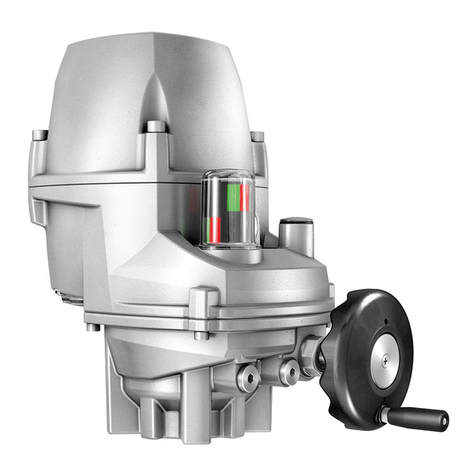
AUMA
AUMA PROFOX PF-Q80 User manual
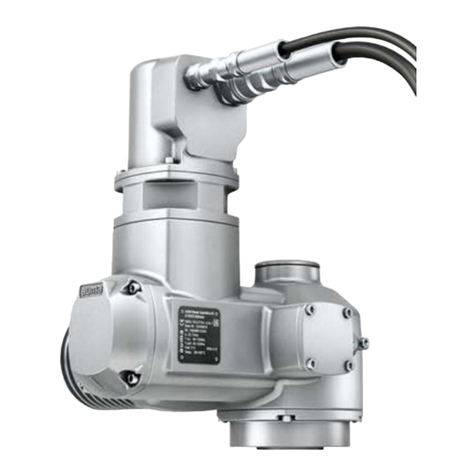
AUMA
AUMA SAEx 07.2-UW User manual
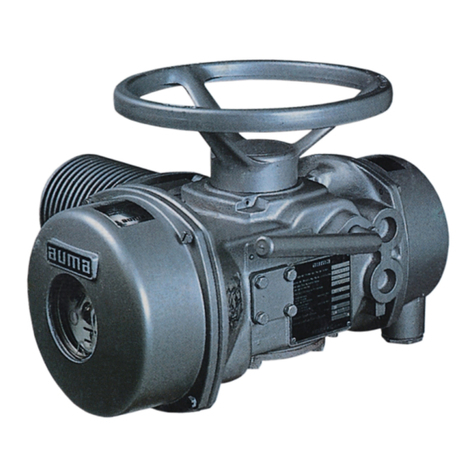
AUMA
AUMA SA 3 User manual
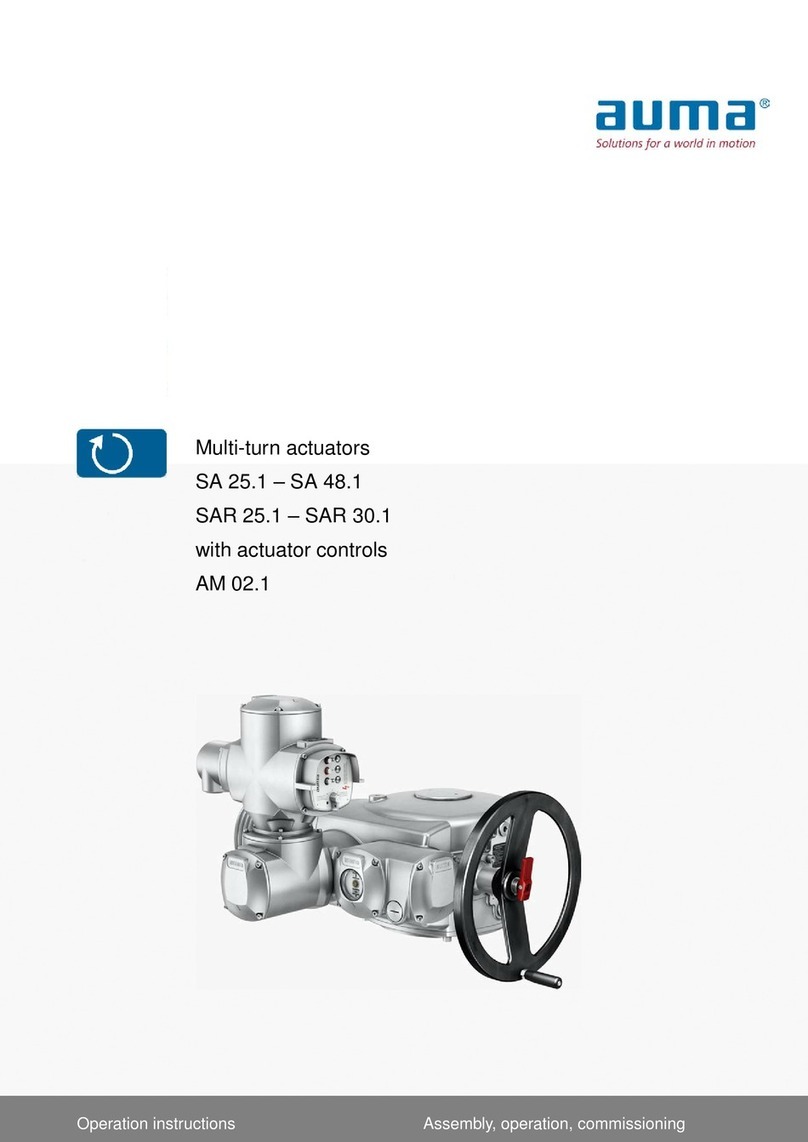
AUMA
AUMA SA 48.1 SAR 25.1 User manual
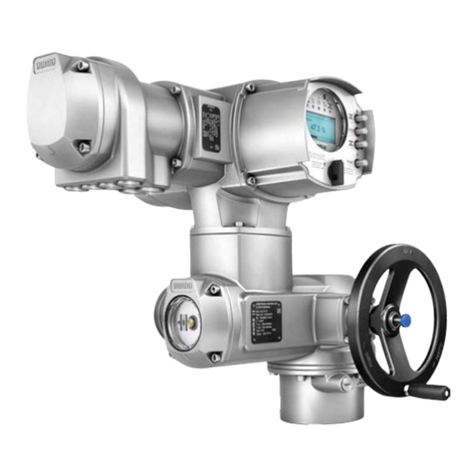
AUMA
AUMA SQ 05.2 User manual
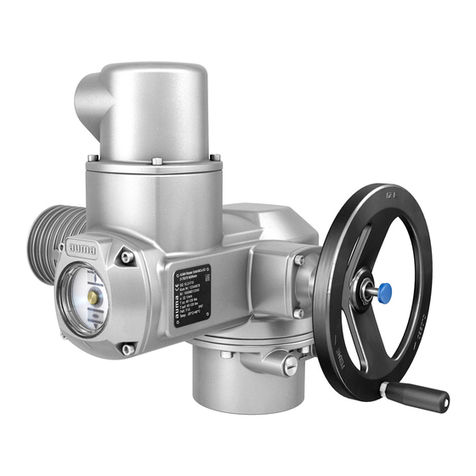
AUMA
AUMA NORM SQ 05.2 Administrator Guide
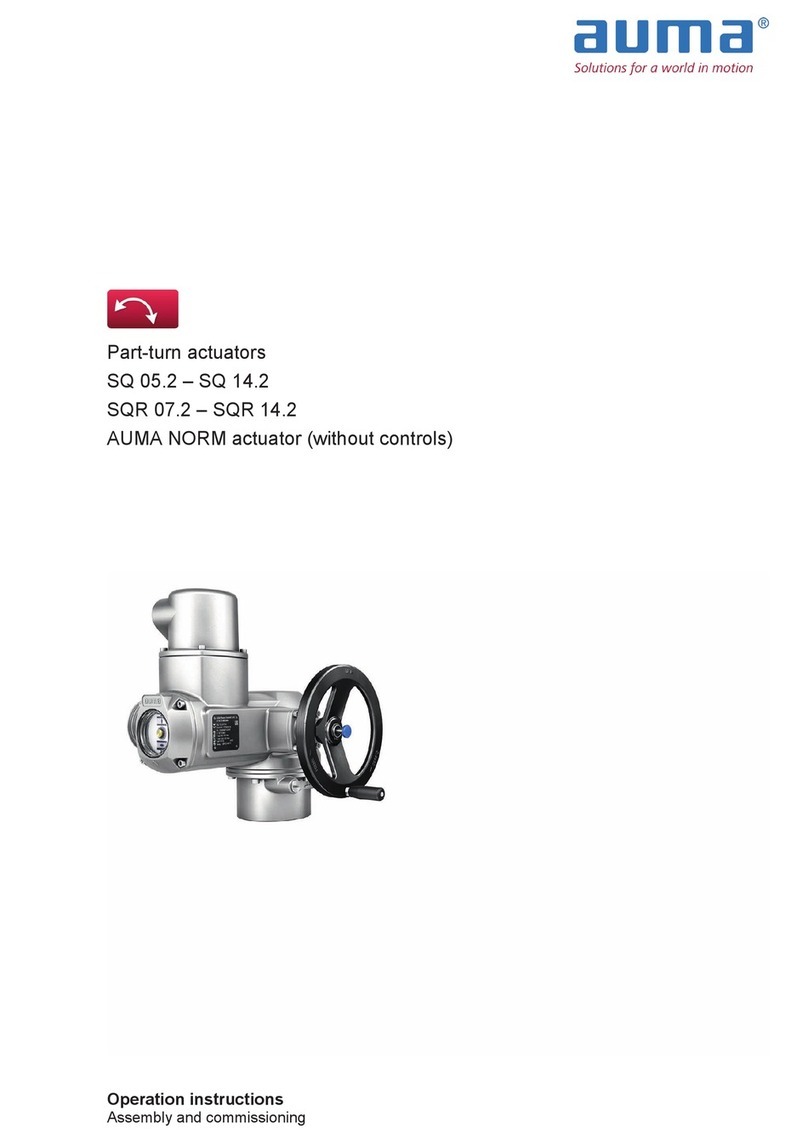
AUMA
AUMA SQ 05.2 User manual
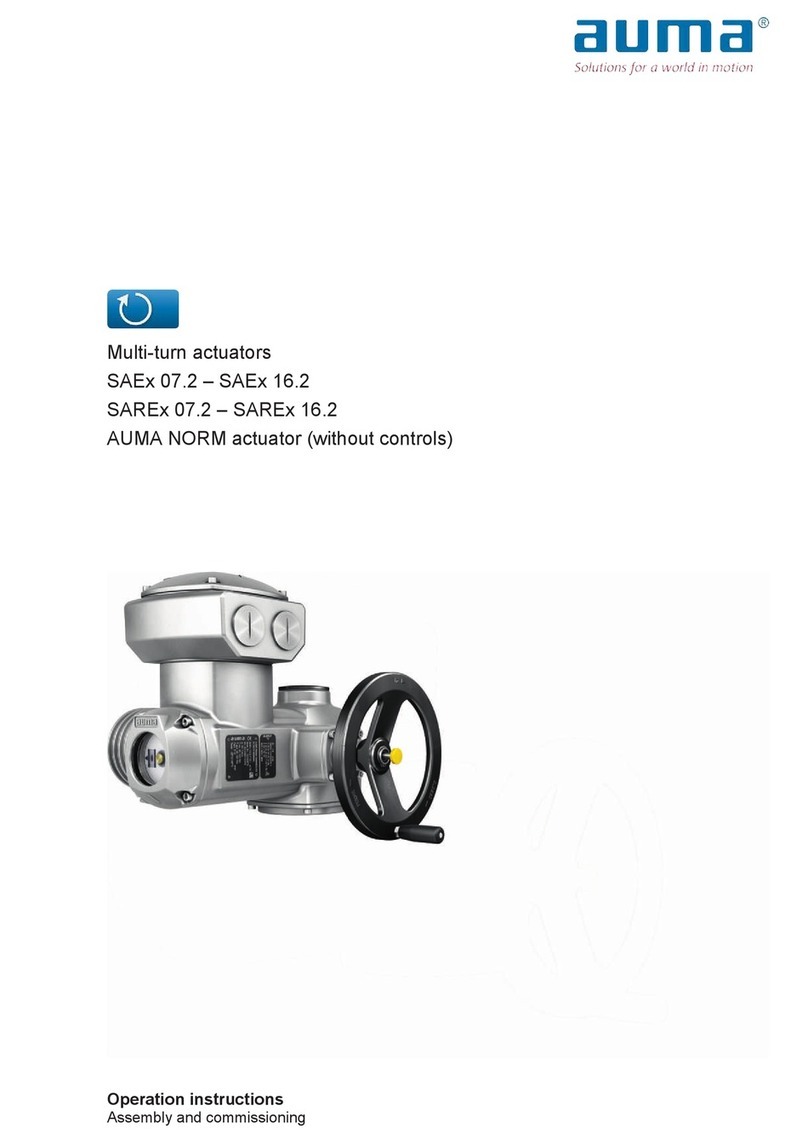
AUMA
AUMA SAEx 07.2 User manual
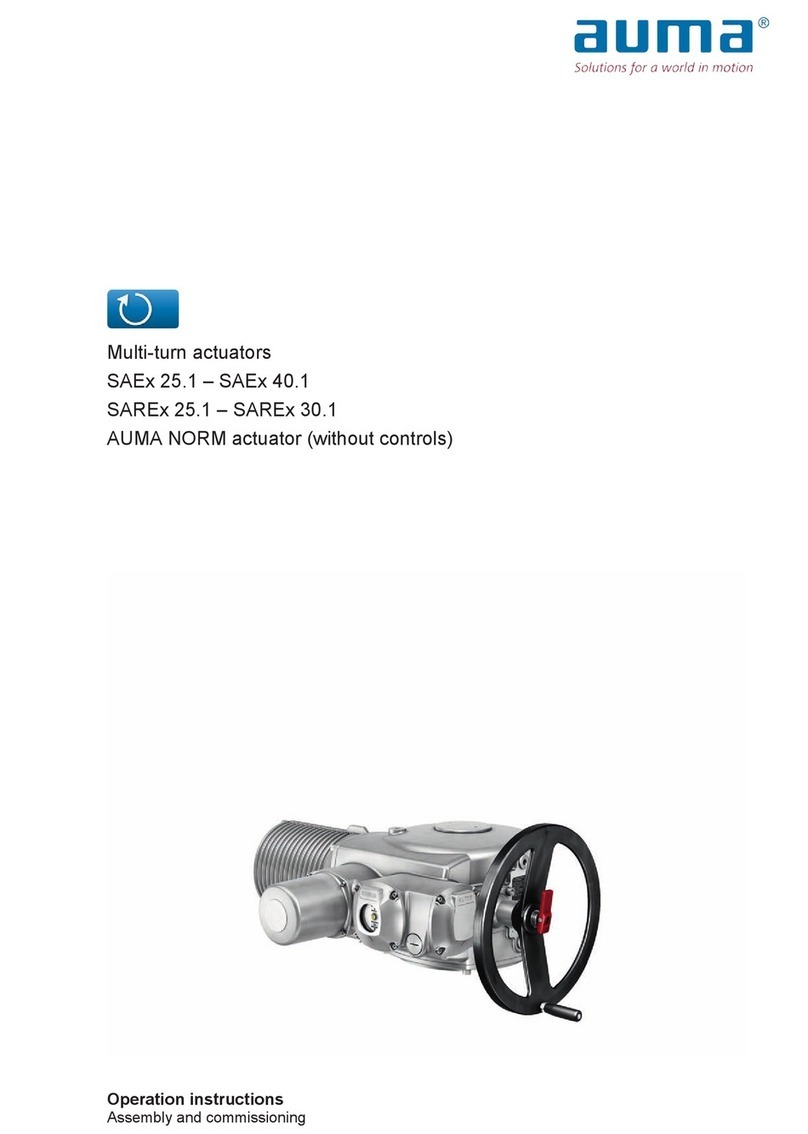
AUMA
AUMA SAEx 25.1 User manual
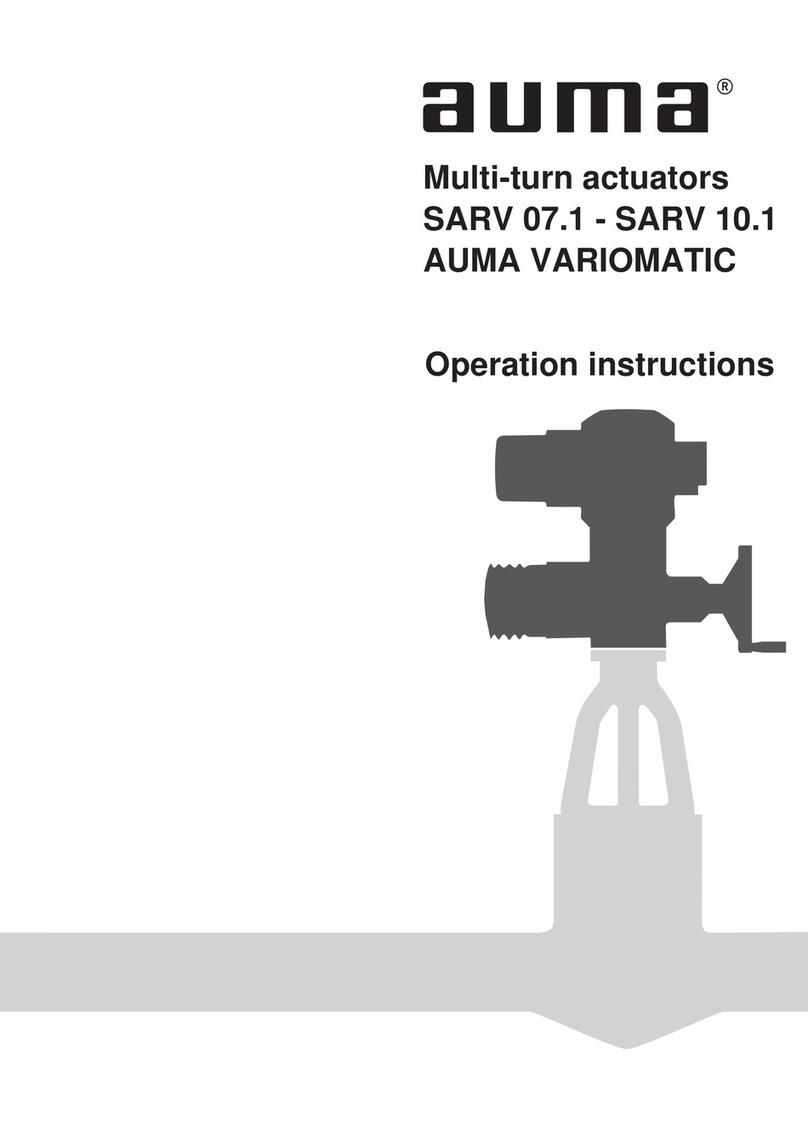
AUMA
AUMA VARIOMATIC SARV 10.1 User manual
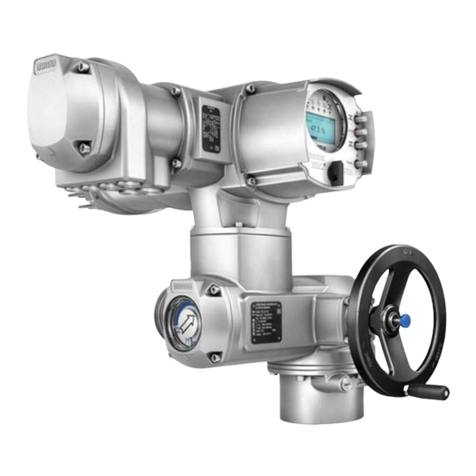
AUMA
AUMA SQV 05.2 User manual

AUMA
AUMA SGM 04.1 User manual
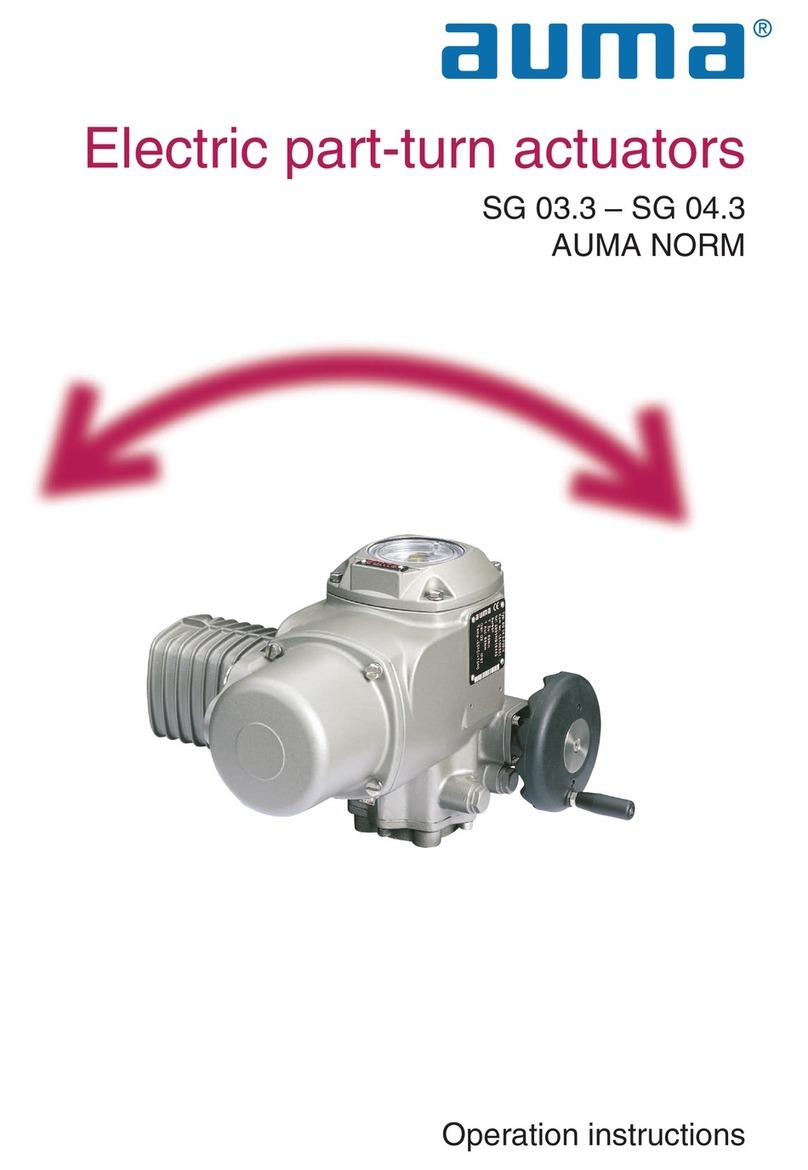
AUMA
AUMA NORM Series User manual
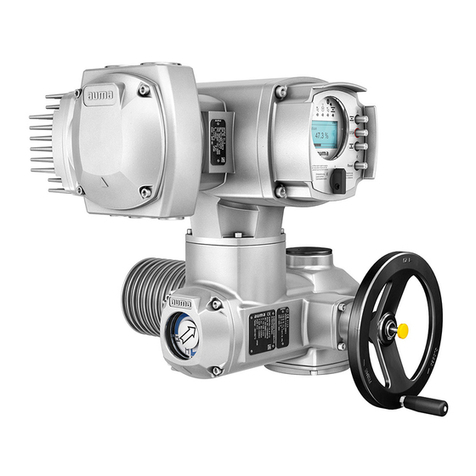
AUMA
AUMA SAVEx Series User manual

AUMA
AUMA SA Series User manual
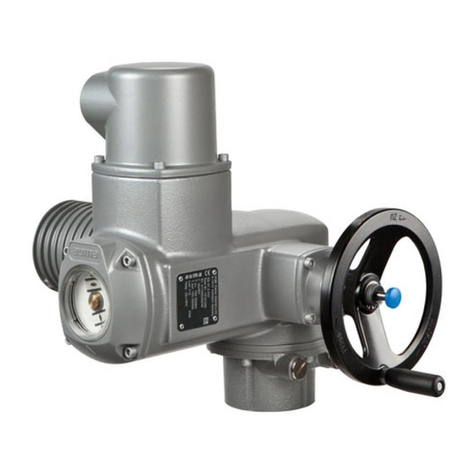
AUMA
AUMA SG 05.1-F05 User manual
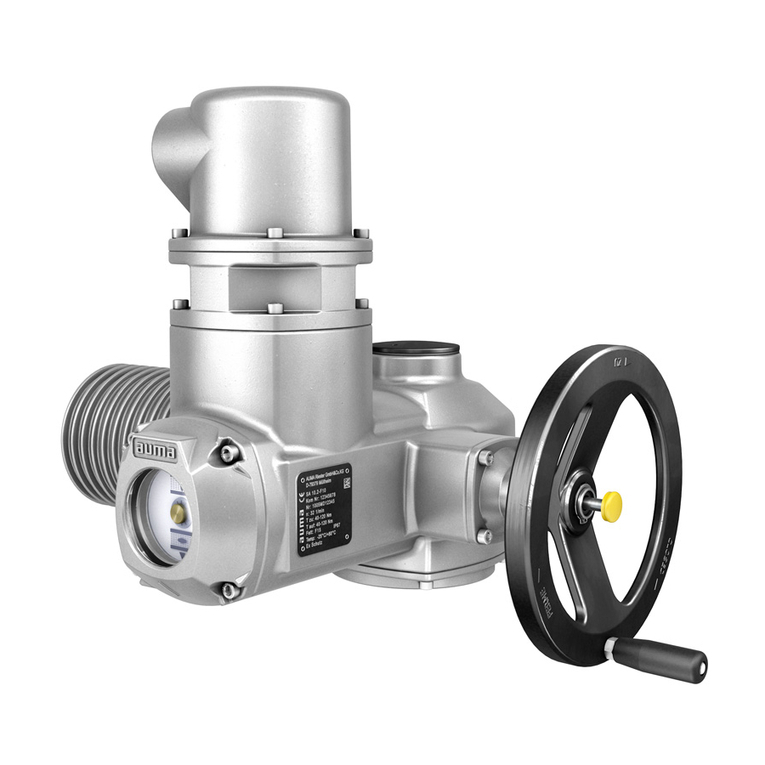
AUMA
AUMA SAEx 07.2 User manual
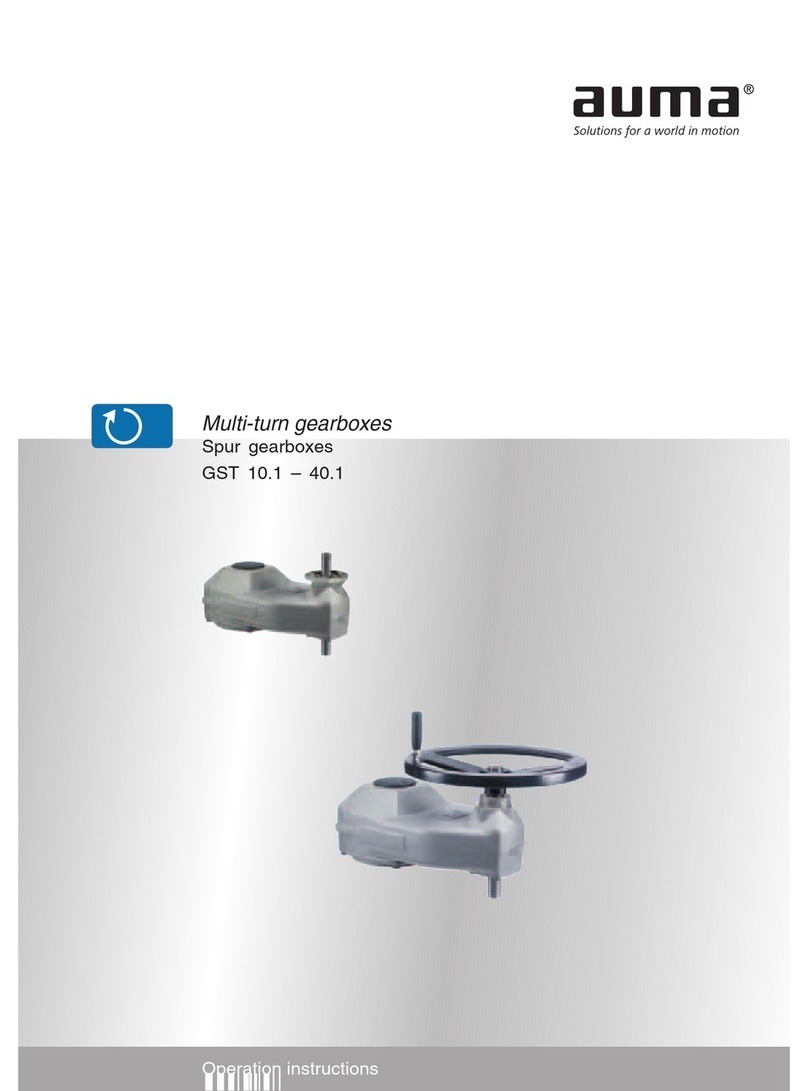
AUMA
AUMA GST 10.1 Administrator Guide
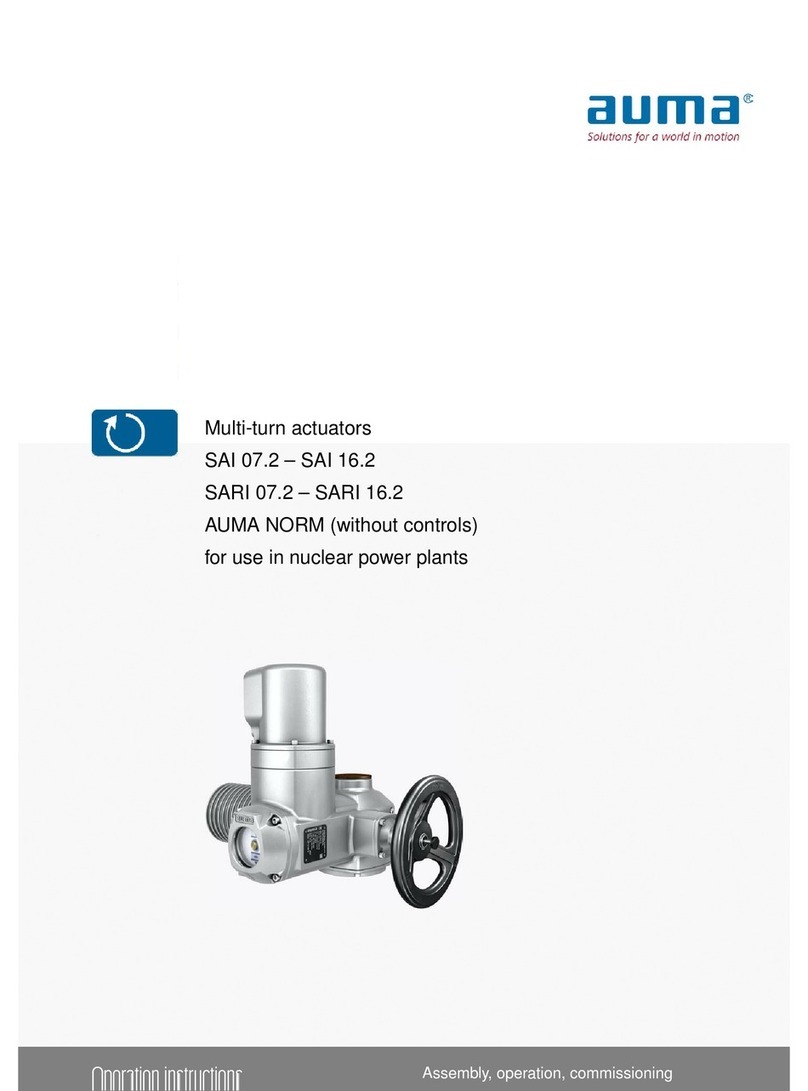
AUMA
AUMA SAI 07.2 User manual

AUMA
AUMA SG 05.1-F05 User manual
